Syngonium: the best tips for caring for a houseplant
Among decorative deciduous plants, there are dense bushes syngonium. Their bright color and unusual leaf shape fully compensates for the lack of flowers. Almost all species grow and develop well in indoor conditions and are not demanding to care for.
Content:
general information
Syngonium is perennial a herbaceous plant that belongs to the Aroid family. Its branches are shaped like vines and can reach several meters in length in natural conditions.
Adult leaves differ in shape from young ones.
At an early age, they are solid, arrow-shaped, but after a certain time, the whole plate is divided into several parts. The color of the leaves depends on the variety.
The flowering plant occurs mainly only in natural conditions. It is a small ear with a white or creamy petal blanket that covers it. Syngonium is a tropical plant, native to the forests of South and Central America.
Varieties
Popular plant varieties:
- Syngonium is auricular. Perennial evergreen liana-like plant. On adult branches, aerial roots are formed in internodes. The leaves are large, smooth, glossy, painted in a dark green tone, located on the branches on petioles, the length of which does not exceed 40 cm. Young leaves are oblong oval, wide, with two ears at the petiole. In the adult state, the leaf has three separate large lobes and two small ones.
- Syngonium Wendland. The bush of this variety is of medium height. The leaves are large, green, in the form of an arrow with three tips. The petioles are high, thick, dark green. The leaf is velvety, colored in a green tone, a light pattern stains the central part and departs from the vein.
- The syngonium is leg-leaved. Perennial plants with branches-lianas, which grow 1.5-2 meters under indoor conditions. The leaves are large, heart-shaped, located on a high petiole. The surface of the leaves is glossy, smooth, the color is light green, pink with a spotted pattern.
- Syngonium "Bob Alyushin". This variety can be classified as undersized. Bushes grows compact, branches are short. Leaves are medium in size, heart-shaped, located on fleshy petioles. In a young state, they have an olive color with pronounced pink veins, which gives the plant a special decorative effect. In good light, the color becomes more saturated.
- Syngonium "Neon Robusta". Perennial herbaceous shrub of low growth. A distinctive feature of this variety is its pink leaves, which are located on large green petioles. The bush is very dense and lush. This variety can be planted with another variety with a green leaf color, which will give the effect of a blooming rose bush.
- Syngonium "Regina Red". A medium-sized bush with greenish-gray stems with a striped pattern. The leaves are densely arranged on the branches due to the small distances between the nodes. The shape of the leaf resembles an arrowhead, the upper part is painted in a muted dark pink tone, the lower part is green.If the plant is placed in a light room, the color will become much brighter and, conversely, in a dark room, the leaves turn pale.
Care
Syngonium is easy to care for. Even a beginner florist will be able to grow a large and healthy bush by following a few simple rules for caring for the plant. In nature, syngonium grows in shaded areas, therefore, when placing it in a room, this detail should be taken into account.
For the period of sunny and warm days of the spring-summer season, it is recommended to install a pot with a plant 1.5-2 meters from the window. But it is also not recommended to put it in dark rooms, as this can lead to thinning of branches and leaves and loss of bright color.
For the winter period, the pot is returned to the windowsill so that the plant receives enough sun, or artificial lighting is installed.
For domesticated tropical crops, it is recommended to maintain an appropriate temperature regime. In the warm season, in the room where the plant is located, the thermometer should not fall below +20 degrees and rise above +25. Winter mode is in the range of + 17- + 19 degrees. A sharp temperature drop can lead to the death of the plant. Also, drafts have a bad effect on the syngonium, therefore, when choosing a place, it must be placed away from the vents.
Watering plants:
- Water the syngonium regularly as the topsoil dries out. It is impossible to allow the roots to dry out, this can lead to the death of the plant.
- Irrigation water should be soft, room temperature and separated for 2-3 days.
- It is also necessary to spray the plant regularly to create a high level of moisture around it. This is especially true in the winter, when the heating systems are constantly on.
You can immediately pour sand into the pot holder, and subsequently moisten it periodically. This will allow the plant to regularly receive adequate moisture at all times. But care must be taken to keep the sand wet. If a lot of water begins to accumulate in the pan, root rot may begin.
It is necessary to carry out the process annually feeding plants in the spring and summer. No fertilization is applied during the winter months. It is also recommended to periodically wipe the leaves with a damp cloth from dust.
The branches of the syngonium require support, therefore, when placing the pot, it is necessary to prepare in advance what to tie vines.
When planting, you can pre-install it in a pot, which will facilitate the transportation of the plant from one place to another. Or each time, carefully untie the branches from the old places and braid around the new ones.
Syngoniums do not need regular pruning branches. Some young shoots are pinched to stimulate the growth of lateral shoots. It is also necessary to remove old and yellowed leaves in order to maintain a neat and decorative shrub.
Transfer
Young bushes transplanted annually, each time increasing the diameter of the pot to give the roots room for development. Adult plants are transplanted every 2-3 years or as needed. To do this, a thick layer of drainage is poured into the pot, which is sprinkled on top with a substrate for Aroid plants. This primer can be purchased at your supermarket or flower shop.
The roots must first be cleaned of dead and sore parts, process light manganese solution.
So that the vines always have something to hold on to, a support is installed in the center. The roots are spread around the entire perimeter and sprinkled with soil on top. You can make the soil for the plant yourself. To do this, it is necessary to mix in equal parts sod land, river sand and peat.
It is recommended to pre-heat the sand in order to disinfect it. You can also pass a solution of potassium permanganate through the finished mixture.
Reproduction
Syngonium reproduces with the help cuttings or dividing the bush... Cuttings can be harvested almost all year round, but spring and summer cuttings take root best of all.
Syngonium cuttings:
- For this, branches are cut from mature ripe vines. Each cutting should have at least one aerial root knot. If the variety does not form many aerial roots, then the cuttings are cut in two knots, and the cuts are made 1 cm from the nearest leaf.
- Cuttings are lowered into the water in such a way that the air roots or nodes are immersed in it. They can be pretreated with a stimulating solution.
- After a time when the roots grow enough for landing, the plants are transferred to small pots with drainage and special substrate.
- Rooting can also be carried out in containers filled with mixed peat with sand.
- After processing, the cuttings are buried in the ground and placed in a warm place where the temperature is kept at least +25 degrees. They are watered periodically.
- When new leaves begin to develop, this is a sign that rooting has gone well.
- After 1-2 weeks, the plant can be transferred to a separate pot.
When growing in an adult bush, many basal shoots are formed. During transplants young bushes can be separated from the plant. To do this, the roots are completely cleared of soil, a young bush is determined so that 3-5 leaves remain on the rhizome.
Such a plant is planted in a pre-prepared pot with a substrate and drainage. From one bush can be separated from 3-7 young shoots. It is recommended to treat the mother and daughter bushes with stimulating and disinfecting solutions.
To stimulate the branching of the tops of the vines, it is recommended to pinch when 6-7 leaves appear on the branches.
Some can be left to braid the support, thus forming a lush and dense bush. Care must be taken when working with syngonium. The sap of the plant is poisonous and, if it comes into contact with the skin or mucous membranes, can be harmful. It is washed off with plenty of running water, and the place of contact is treated with a disinfectant. It is advisable to carry out all work in protective gloves.
Diseases and pests
Syngonium is quite resistant to diseases plant. Everything diseases can start from improper care of him.
Syngonium diseases:
- If the tips of the leaves begin to dry out, this is a sign that the air around the flower is very dry. If the house has an aquarium, the plant can be placed near it. Continuous evaporation of the water will provide a sufficient amount of moisture. You can also increase the amount spraying or put a special humidifier.
- The leaves begin to turn yellow, and the bases of the petioles rot, the whole flower withers - this shows the unhealthy state of the roots. Two aspects can lead to this: a strong waterlogging of the roots, as a result of which they began to rot, or, conversely, a lack of moisture, which led to the drying out and death of some roots. To restore a plant, it is necessary transplant, after cleaning the roots and treating them with a solution of potassium permanganate.
- The roots are cleaned, the rotten areas are completely cut off. If the roots are dry, they are placed in water for a while to saturate. After processing the roots, fresh drainage and a new substrate are poured into a new pot, into which the plant is placed.
- If the leaves have begun to turn yellow, but there are no signs of rotting, this is a sign that the soil is lacking in nutrients. It is recommended to make a universal fertilizer 2-3 times within 10 weeks.
Syngonium pests:
- Of the pests, aphids can attack the syngonium. It can be removed by washing the entire flower and all plants that are nearby in a soapy solution. After a while, repeat the procedure. If the infection persists, then all plants in the room are treated with special insecticides.
- Scabbard and thrips also occasionally appear on bushes. They are fought with special drugswhich can be purchased at any gardening store.The thyroid gland can appear not only on the outside of the sheet, but also on the bottom. Therefore, it is necessary to periodically review the plant and check its health. Thrips can be seen by white dots on the surface of the leaf.
- Spider mites can be removed using the same control method as with aphids. In this case, it is recommended to repeat the process after 2 days and observe the plant. Basically, pests appear with improper care, so the treatment should be comprehensive and take into account all the shortcomings.
Application
Syngonium is a rather unpretentious plant with decorative and large leaves. It is mainly used as a house plant. Grown on windowsills and in winter gardens. Also, the plants will look good in offices and offices.
Thanks to its branches and intensive growth, several syngonium pots can green a large room.
In botanical gardens, you can find a large number of different varieties and hybrids of the syngonium. Often in conditions close to tropical, they bloom.
More information can be found in the video.



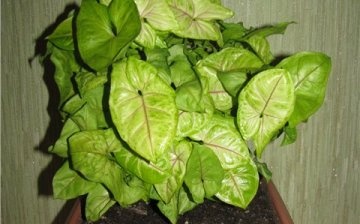


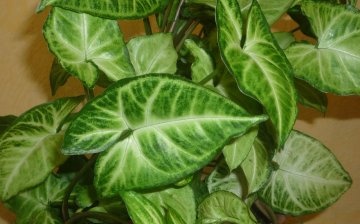
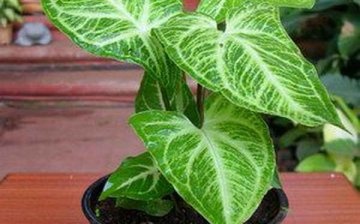


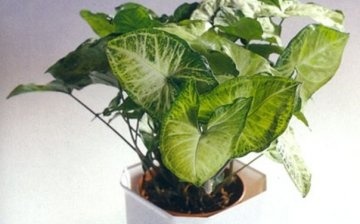









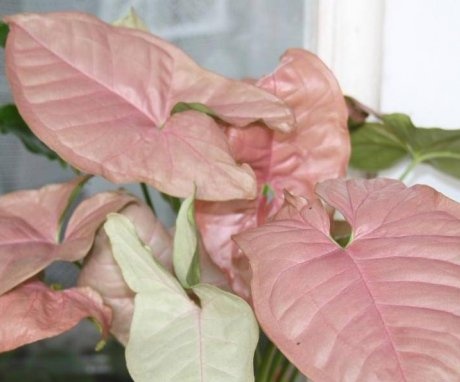
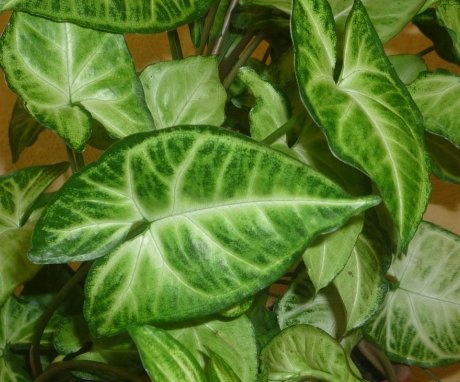
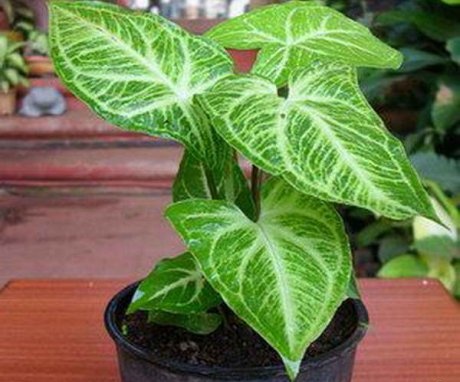
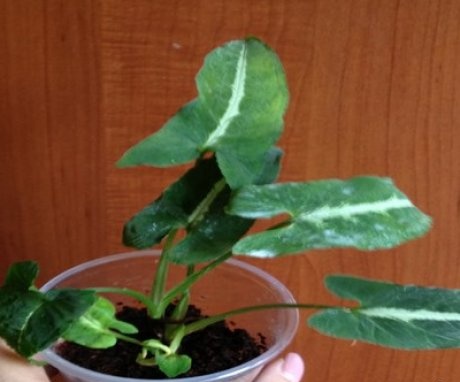
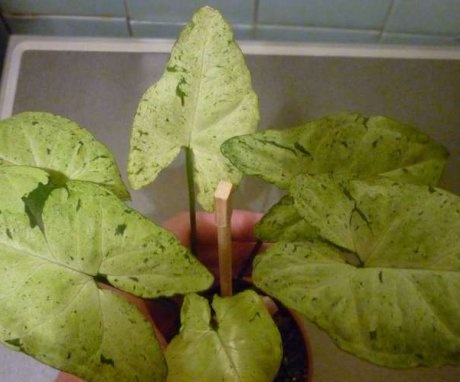
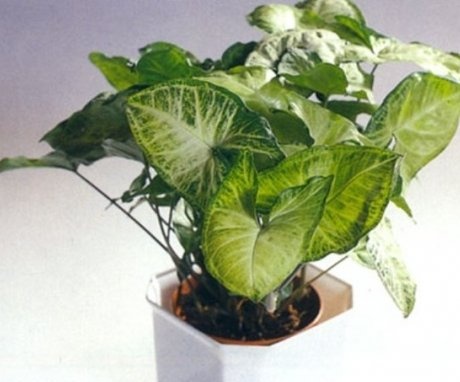
And then I wonder why my syngonium is not growing. It turns out that I am not looking after him properly. He was always drying out for me. Yes, and I forgot to spray it, as luck would have it, and stood in the shade. Now we need to change the conditions for him.